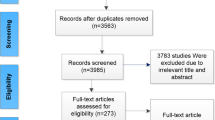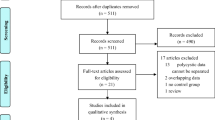Abstract
Purpose
To examine available data from randomized controlled trials to assess if the freeze-all embryo and subsequent frozen-thawed embryo transfer (FET) results in better clinical outcomes than fresh embryo transfer (ET).
Methods
Meta-analysis.
Results
We conducted an electronic literature search on PubMed and Embase databases and manually supplemented another 2 articles from relevant citations. Seven studies were finally included in the meta-analysis,including 1141 women who underwent fresh embryo transfer and 1079 who underwent frozen embryo transfer. The results of the meta-analysis suggested that the live birth rate [RR (95% CI) 1.18 (1.08–1.30), P = 0.0003] and clinical pregnancy rate [RR (95% CI) 1.10 (1.02–1.19), P = 0.02] were significantly higher in FET group. Miscarriage rate [RR (95% CI) 0.62 (0.48–0.80), P = 0.0002], and moderate to severe OHSS occurrence rate [RR (95% CI) 0.22 (0.12 to 0.39), P < 0.00001] were significantly lower in FET group. Differences of biochemical pregnancy rate, ongoing pregnancy rate and implantation rate between the two groups did not reach the statistical significance.
Conclusions
Our results suggest that the IVF/ICSI with FET is more efficient and less risky for OHSS compared with ET. However, we should comprehensively inform patients with advantages, disadvantages and potential risks related to embryo cryopreservation, and carefully assess their fertility conditions to make the most beneficial clinical decision.


Similar content being viewed by others
References
Direkvand-Moghadam A, Delpisheh A, Khosravi A (2013) Epidemiology of female infertility; a review of literature. Biosci Biotechnol Res Asia 10(2):559–567
Wong KM, Mastenbroek S, Repping S (2014) Cryopreservation of human embryos and its contribution to in vitro fertilization success rates. Fertil Steril 102(1):19–26
Chen ZJ, Shi Y, Sun Y, Zhang B, Liang X, Cao Y et al (2016) Fresh versus frozen embryos for infertility in the polycystic ovary syndrome. N Engl J Med 375(6):523–533
Coates A, Kung A, Mounts E, Hesla J, Bankowski B, Barbieri E et al (2017) Optimal euploid embryo transfer strategy, fresh versus frozen, after preimplantation genetic screening with next generation sequencing: a randomized controlled trial. Fertil Steril 107(723–30):e3
Ferraretti AP, Gianaroli L, Magli C, Fortini D, Selman HA, Feliciani E (1999) Elective cryopreservation of all pronucleate embryos in women at risk of ovarian hyperstimulation syndrome: efficiency and safety. Hum Reprod (Oxford, England) 14:1457–1460
Yang S, Pang T, Li R, Yang R, Zhen X, Chen X et al (2015) The individualized choice of embryo transfer timing for patients with elevated serum progesterone level on the HCG day in IVF/ICSI cycles: a prospective randomized clinical study. Gynecol Endocrinol 31:355–358
Shaker AG, Zosmer A, Dean N, Bekir JS, Jacobs HS, Tan SL (1996) Comparison of intravenous albumin and transfer of fresh embryos with cryopreservation of all embryos for subsequent transfer in prevention of ovarian hyperstimulation syndrome. Fertil Steril 65:992–996
Shapiro BS, Daneshmand ST, Garner FC, Aguirre M, Hudson C, Thomas S (2011) Evidence of impaired endometrial receptivity after ovarian stimulation for in vitro fertilization: a prospective randomized trial comparing fresh and frozen-thawed embryo transfer in normal responders. Fertil Steril 96:344–348
Shapiro BS, Daneshmand ST, Garner FC, Aguirre M, Hudson C, Thomas S (2011) Evidence of impaired endometrial receptivity after ovarian stimulation for in vitro fertilization: a prospective randomized trial comparing fresh and frozen-thawed embryo transfers in high responders. Fertil Steril 96:516–518
Moher D, Liberati A, Tetzlaff J, Altman DG, Group TP (2009) Preferred reporting items for systematic reviews and meta-analyses: the PRISMA statement. Rev Esp Nutr Hum Diet 18:889–896
Golan A, Weissman A (2009) A modern classification of OHSS. Reprod Biomed Online 19:28–32
Shuster JJ (2011) Review: Cochrane handbook for systematic reviews for interventions, Version 5.1.0, published 3/2011. In: Higgins JPT, Green S (eds) Res Synth Methods vol 2:126–130
Wong KM, van Wey M, Mol F, Repping S, Mastenbroek S (2017) Fresh versus frozen embryo transfers in assisted reproduction. Cochrane Database Syst Rev 3:Cd011184
Roque M, Lattes K, Serra S, Garcia-De-Jesus S, Cantillo A, Geber S et al (2012) Fresh embryo transfer versus frozen-thawed embryo transfer in assisted reproduction technique cycles: a systematic review and meta-analysis. In: 28th Annual meeting of European Society of Human Reproduction and Embryology (ESHRE) Congress; 2012 Feb 05; Hum Reprod 2012
Legro RS, Wu X, Barnhart KT, Farquhar C, Fauser BC, Mol B (2014) Improving the reporting of clinical trials of infertility treatments (IMPRINT): modifying the CONSORT statementdaggerdouble dagger. Hum Reprod (Oxford, England) 29:2075–2082
Rodriguez-Purata J, Lee J, Whitehouse M, Duke M, Grunfeld L, Sandler B et al (2016) Reproductive outcome is optimized by genomic embryo screening, vitrification, and subsequent transfer into a prepared synchronous endometrium. J Assist Reprod Gen 33:401–412
Shapiro BS, Daneshmand ST, Restrepo H, Garner FC, Aguirre M, Hudson C (2013) Matched-cohort comparison of single-embryo transfers in fresh and frozen-thawed embryo transfer cycles. Fertil Steril 99:389–392
Awonuga AO, Pittrof RJ, Zaidi J, Dean N, Jacobs HS, Tan SL (1996) Elective cryopreservation of all embryos in women at risk of developing ovarian hyperstimulation syndrome may not prevent the condition but reduces the live birth rate. J Assist Reprod Gen 13:401–406
Bourne H, Richings N, Harari O, Watkins W, Speirs AL, Johnston WI et al (1995) The use of intracytoplasmic sperm injection for the treatment of severe and extreme male infertility. Reprod Fertil Dev 7:237–245
Wang CZ, Feng GX, Zhang B, Zhou H, Shu JH, Gan XY et al (2014) Chen HH. [Effects of IVF versus ICSI on the outcomes of elective blastocyst culture. Zhonghua Nan Ke Xue 20(8):697–701
Nouri K, Ott J, Stoegbauer L, Pietrowski D, Frantal S, Walch K (2013) Obstetric and perinatal outcomes in IVF versus ICSI-conceived pregnancies at a tertiary care center–a pilot study. Reprod Biol Endocrinol 11:84
Elgindy EA, Abou-Setta AM, Mostafa MI (2011) Blastocyst-stage versus cleavage-stage embryo transfer in women with high oestradiol concentrations: randomized controlled trial. Reprod Biomed Online 23(6):789–798
Fang C, Huang R, Wei LN, Jia L (2015) Frozen-thawed day 5 blastocyst transfer is associated with a lower risk of ectopic pregnancy than day 3 transfer and fresh transfer. Fertil Steril 103(3):655–661.e3
Glujovsky D, Farquhar C, Quinteiro Retamar AM, Alvarer Sedo CR, Blake D (2012) Cleavage stage versus blastocyst stage embryo transfer in assisted reproductive technology. Cochrane Database Syst Rev 7:Cd002118
Li RR, Dong YZ, Guo YH, Sun YP, Su YC, Chen F (2013) Comparative study of pregnancy outcomes between day 3 embryo transfer and day 5 blastocyst transfer in patients with progesterone elevation. J Int Med Res 41(4):1318–1325
Papanikolaou EG, Camus M, Fatemi HM, Tournaye H, Verheyen G, Van Steirteghem A et al (2006) Early pregnancy loss is significantly higher after day 3 single embryo transfer than after day 5 single blastocyst transfer in GnRH antagonist stimulated IVF cycles. Reprod Biomed Online 12(1):60–65
Kolibianakis E, Bourgain C, Albano C, Osmanagaoglu K, Smitz J, Steirteghem AV et al (2002) Effect of ovarian stimulation with recombinant follicle-stimulating hormone, gonadotropin releasing hormone antagonists, and human chorionic gonadotropin on endometrial maturation on the day of oocyte pick-up. Fertil Steril 78:1025–1029
Ubaldi F, Bourgain C, Tournaye H, Smitz J, Van SA, Devroey P (1997) Endometrial evaluation by aspiration biopsy on the day of oocyte retrieval in the embryo transfer cycles in patients with serum progesterone rise during the follicular phase. Fertil Steril 67:521–526
Horcajadas JA, Riesewijk A, Polman J, Os RV, Pellicer A, Mosselman S et al (2005) Effect of controlled ovarian hyperstimulation in IVF on endometrial gene expression profiles. Mol Hum Reprod 11:195–205
Van VI, Van LL, Ghislain V, In’T VP, Schuit F, Fatemi HM et al (2009) In GnRH antagonist/rec-FSH stimulated cycles, advanced endometrial maturation on the day of oocyte retrieval correlates with altered gene expression. Hum Reprod 24:1085–1091
Roque M, Valle M, Kostolias A, Sampaio M, Geber S (2017) Freeze-all cycle in reproductive medicine: current perspectives. JBRA Assist Reprod 21:49–53
Maheshwari A, Pandey S, Shetty A, Hamilton M, Bhattacharya S (2012) Obstetric and perinatal outcomes in singleton pregnancies resulting from the transfer of frozen thawed versus fresh embryos generated through in vitro fertilization treatment: a systematic review and meta-analysis. Fertil Steril 98:368–377.e1–9
Nakashima A, Araki R, Tani H, Ishihara O, Kuwahara A, Irahara M et al (2013) Implications of assisted reproductive technologies on term singleton birth weight: an analysis of 25,777 children in the national assisted reproduction registry of Japan. Fertil Steril 99:450–455
Ishihara O, Araki R, Kuwahara A, Itakura A, Saito H, Adamson GD (2014) Impact of frozen-thawed single-blastocyst transfer on maternal and neonatal outcome: an analysis of 277,042 single-embryo transfer cycles from 2008 to 2010 in Japan. Fertil Steril 101:128–133
Yin L, Hang F, Gu LJ, Xu B, Ma D, Zhu GJ (2013) Analysis of birth defects among children 3 years after conception through assisted reproductive technology in China. Birth Defects Res A Clin Mol Teratol 97:744–749
Shapiro BS, Daneshmand ST, Bedient CE, Garner FC (2016) Comparison of birth weights in patients randomly assigned to fresh or frozen-thawed embryo transfer. Fertil Steril 106:317–321
Wennerholm UB, Henningsen AK, Romundstad LB, Bergh C, Pinborg A, Skjaerven R et al (2013) Perinatal outcomes of children born after frozen-thawed embryo transfer: a Nordic cohort study from the CoNARTaS group. Hum Reprod (Oxford, England) 28:2545–2553
Maldonado MB, Penteado JC, Faccio BM, Lopes FL, Arnold DR (2015) Changes in tri-methylation profile of lysines 4 and 27 of histone H3 in bovine blastocysts after cryopreservation. Cryobiology 71:481–485
Saenz-De-Juano MD, Peñaranda DS, Marco-Jiménez F, Vicente JS (2014) Does vitrification alter the methylation pattern of OCT4 promoter in rabbit late blastocyst? Cryobiology 69:178–180
Riesco MF, Robles V (2013) Cryopreservation causes genetic and epigenetic changes in zebrafish genital ridges. PLoS ONE 8(6):e67614
Tarín JJ, Garcíapérez MA, Cano A (2014) Assisted reproductive technology results: why are live-birth percentages so low? Mol Reprod Dev 81:568–583
Funding
The authors declare that we have no financial support from any organization.
Author information
Authors and Affiliations
Corresponding author
Ethics declarations
Conflict of interest
The authors declare that we have no conflict of interest.
The authors agree to allow the Journal to review our data if requested.
Ethical approval
The authors declare that there are no ethical issues in this study due to no intervention was given to patients when performed a meta-analysis.
Electronic supplementary material
Below is the link to the electronic supplementary material.
Rights and permissions
About this article
Cite this article
Zhang, W., Xiao, X., Zhang, J. et al. Clinical outcomes of frozen embryo versus fresh embryo transfer following in vitro fertilization: a meta-analysis of randomized controlled trials. Arch Gynecol Obstet 298, 259–272 (2018). https://doi.org/10.1007/s00404-018-4786-5
Received:
Accepted:
Published:
Issue Date:
DOI: https://doi.org/10.1007/s00404-018-4786-5




